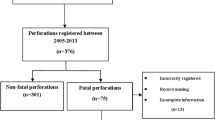Abstract
Background
The management of endoscopic retrograde cholangiopancreatography (ERCP)-related perforations remains controversial. Τhe aim of the study was to determine the incidence of perforations following ERCP, their characteristics, operative and non-operative management options and clinical outcome.
Methods
A retrospective review of ERCP-related perforations, during a 21-year period, was performed. Each perforation was categorized into types I to IV according to the location, mechanism and radiographic evaluation of the injury. Comparisons were made between patients treated operatively and non-operatively.
Results
Forty-four perforations (0.4%) occurred in 9,880 procedures. They were mainly caused by the passage of the endoscope (type I) in 7 (16%) and sphincterotomy (type II) in 30 (68%) patients. The management was non-operative in 32 (72%) and operative in 12 patients. In multivariate analysis, only the type of perforation (type I: endoscope-related) was found significant for predicting operative treatment. The hospital stay was longer for patients requiring an operation (median, 24 vs 9 days). The overall mortality was 2/44 (4.5%). There was no death in the non-operative group.
Conclusions
The need for immediate operative intervention should be based on the type of injury and clinical findings. Patients with type I perforations should be treated surgically and primary repair should be tried. Patients with type II injuries may be treated initially non-operatively. Delayed operative intervention will be required in a minority of these patients.




Similar content being viewed by others
References
Fatima J, Baron TH, Topazian MD, Houghton SG, Iqbal CW, Ott BJ, Farley DR, Farnell MB, Sarr MG. Pancreatobiliary and duodenal perforations after periampullary endoscopic procedures: diagnosis and management. Arch Surg 2007; 142:448–54; discussion 454–5.
Freeman ML. Complications of endoscopic biliary sphincterotomy: a review. Endoscopy 1997; 29:288–97.
Stapfer M, Selby RR, Stain SC, Katkhouda N, Parekh D, Jabbour N, Garry D. Management of duodenal perforation after endoscopic retrograde cholangiopancreatography and sphincterotomy. Ann Surg 2000; 232:191–198.
Enns R, Eloubeidi MA, Mergener K, Jowell PS, Branch MS, Pappas TM, Baillie J. ERCP-related perforations: risk factors and management. Endoscopy 2002; 34:293–98.
Freeman ML, Nelson DB, Sherman S, Haber GB, Herman ME, Dorsher PJ, Moore JP, Fennerty MB, Ryan ME, Shaw MJ, Lande JD, Pheley AM. Complications of endoscopic sphincterotomy. N Engl J Med 1996; 335:909–18.
Avgerinos DV, Llaguna OH, Lo AY, Voli J, Leitman IM. Management of endoscopic retrograde cholangiopancreatography: related duodenal perforations. Surg Endosc 2009; 23:833–38.
Howard TJ, Tan T, Lehman GA, Sherman S, Madura JA, Fogel E, Swack ML, Kopecky KK. Classification and management of perforations complicating endoscopic sphincterotomy. Surgery 1999; 126:658–63.
Preetha M, Chung YF, Chan WH, Ong HS, Chow PK, Wong WK, OOi LL, Soo KC. Surgical management of endoscopic retrograde cholangiopancreatography-related perforations. ANZ J Surg 2003; 73(12):1011–14.
Cotton PB, Lehman G, Vennes J, Geenen JE, Russell RC, Meyers WC, Liguory C, Nickl N. Endoscopic sphincterotomy complications and their management: an attempt at consensus. Gastrointest Endosc 1991; 37:383–93.
Panteris V, Vezakis A, Filippou G, Filippou D, Karamanolis D, Rizos S. Influence of juxtapapillary diverticula on the success or difficulty of cannulation and complication rate. Gastrointest Endosc 2008; 68(5):903–10.
Lai CHE, Lau WY. Management of endoscopic retrograde cholangiopancreatography related perforation. Surgeon 2008; 6(1):45–48.
De Vries JH, Duijm LE, Dekker W, Guit GL, Ferwerda J, Scholten ET. CT before and after ERCP: detection of pancreatic pseudotumor, asymptomatic retroperitoneal perforation, and duodenal diverticulum. Gastrointest Endosc 1997; 45:231–35.
Genzlinger JL, McPhee MS, Fisher JK, Jacob KM, Helzberg JH. Significance of retroperitoneal air after endoscopic retrograde cholangiopancreatography with sphincterotomy. Am J Gastroenterol 1999; 94:1267–70.
Assalia A, Suissa A, Ilivitzki A, Mahajna A, Yassin K, Hashmonai M, Krausz MM. Validity of clinical criteria in the management of endoscopic retrograde cholangiopancreatography-related duodenal perforations. Arch Surg 2007; 142(11):1059–64.
Knudson K, Raeburn CD, McIntyre RC, Shah RJ, Chen YK, Brown WR, Stiegmann G. Management of duodenal and pancreatobiliary perforations associated with periampullary endoscopic procedures. Am J Surg 2008; 196:975–82.
Ferrara F, Luigiano C, Billi P, Jovine E, Cinquantini F, D’ Imperio N. Pneumothorax, pneumomediastinum, pneumoperitoneum, pneumoretroperitoneum and subcutaneous emphysema after ERCP. Gastrointest Endosc 2009; 69(7):1398–401.
Baron TH, Gostout CJ, Herman L. Hemoclip repair of a sphincterotomy-induced duodenal perforation. Gastrointest Endosc 2000; 52(4):566–568.
Multignani M, Iacopinin F, Dokas S, Larghi A, Familiari P, Tringali A, Costamagna G. Successful endoscopic closure of a lateral duodenal perforation at ERCP with fibrin glue. Gastrointest Endosc 2006; 63:725–27.
Disclosures
Drs. Andreas Polydorou, Antonios Vezakis, Georgios Fraguludis, Demetrios Katsarelias, Constantinos Vagianos, and Georgios Polymeneas have no conflicts of interest or financial ties to disclose.
Author information
Authors and Affiliations
Corresponding author
Rights and permissions
About this article
Cite this article
Polydorou, A., Vezakis, A., Fragulidis, G. et al. A Tailored Approach to the Management of Perforations Following Endoscopic Retrograde Cholangiopancreatography and Sphincterotomy. J Gastrointest Surg 15, 2211–2217 (2011). https://doi.org/10.1007/s11605-011-1723-3
Received:
Accepted:
Published:
Issue Date:
DOI: https://doi.org/10.1007/s11605-011-1723-3




